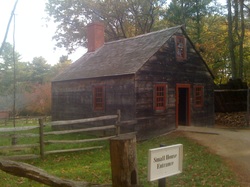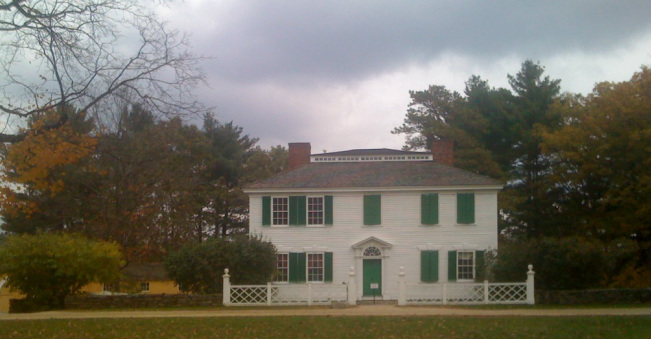
Monday, October 24, 2011
Old Sturbridge Village is a living history museum that portrays life in New England during the 1830s. All the structures are authentic, but have been moved to the site to emulate a village from the time period. There are many businesses including a tavern, a tin shop, a law office, a printing office, etc. We especially enjoyed the Fenno House which depicted the life of a widow and her daughter who engaged in spinning and weaving. Raw cotton, wool, flax, and silk fibers were on display in the house, and wool carding brushes were available so visitors could try their hand at it. The widow was there spinning with her loom nearby. Upstairs were two bed chambers with quilts, a sewing table, and some furnishings and costumes from the period.
There were several exhibits housed in period buildings. The ones we really enjoyed were the glass exhibit and the textiles exhibit (of course!). The textile exhibit had examples of hand looms, and power looms. The museum put a great emphasis on how the spinning and weaving technology that developed during the late 17th and early 18th centuries impacted the lifestyles of New Englanders. Less and less spinning and weaving was occurring in homes. Technology to improve farming techniques decreased the amount of time required to raise crops. Transportation became faster, and more available. Fewer farms gave way to urban life where factory and trade work was available. By 1840, more than 670 cotton factories were operating in New England. Fewer and fewer people were purchasing cloth rather than weaving it in their homes. The economy was transformed and the textile industry became the most important industry in New England for the next 150 years.
The textile exhibit had examples of hand and power looms, exhibits that featured recipes for dying cloth, and samples of drafts (patterns) and weaving patterns that survived from the 19th Century. These patterns were for overshot bed coverlets and diaper cloth for tablecloths and dishtowels. The patterns had all the information to set up the loom and how to weave the pattern. These patterns were recorded by a mother and daughter from Dartmouth, Massachusetts.
Old Sturbridge Village is a living history museum that portrays life in New England during the 1830s. All the structures are authentic, but have been moved to the site to emulate a village from the time period. There are many businesses including a tavern, a tin shop, a law office, a printing office, etc. We especially enjoyed the Fenno House which depicted the life of a widow and her daughter who engaged in spinning and weaving. Raw cotton, wool, flax, and silk fibers were on display in the house, and wool carding brushes were available so visitors could try their hand at it. The widow was there spinning with her loom nearby. Upstairs were two bed chambers with quilts, a sewing table, and some furnishings and costumes from the period.
There were several exhibits housed in period buildings. The ones we really enjoyed were the glass exhibit and the textiles exhibit (of course!). The textile exhibit had examples of hand looms, and power looms. The museum put a great emphasis on how the spinning and weaving technology that developed during the late 17th and early 18th centuries impacted the lifestyles of New Englanders. Less and less spinning and weaving was occurring in homes. Technology to improve farming techniques decreased the amount of time required to raise crops. Transportation became faster, and more available. Fewer farms gave way to urban life where factory and trade work was available. By 1840, more than 670 cotton factories were operating in New England. Fewer and fewer people were purchasing cloth rather than weaving it in their homes. The economy was transformed and the textile industry became the most important industry in New England for the next 150 years.
The textile exhibit had examples of hand and power looms, exhibits that featured recipes for dying cloth, and samples of drafts (patterns) and weaving patterns that survived from the 19th Century. These patterns were for overshot bed coverlets and diaper cloth for tablecloths and dishtowels. The patterns had all the information to set up the loom and how to weave the pattern. These patterns were recorded by a mother and daughter from Dartmouth, Massachusetts.
We toured the Salem Towne House, built in 1796 and moved to Old Sturbridge Village in 1952. I was surprised by how nice it was. There was lots and lots of wallpaper! There was a carpet in the front parlor. The pattern was a repeated block and looked like quilt squares to me. In the center hall and dining room there was canvas on the floor that had been painted to look like carpet. Interesting to see that. The guide said the home would have belonged to an upper middle class family. It was very, very nice. There were quilts on the beds up stairs, but we couldn't get close enough to see them very well.


 RSS Feed
RSS Feed